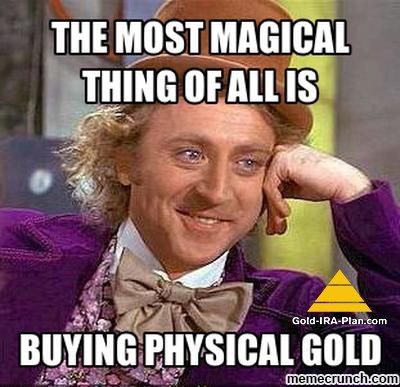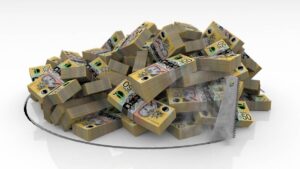EXPLAINER: How currency fluctuations affect the value of gold in your portfolio

Pic: d3sign / Moment via Getty Images
If you’ve been following the rise, and rise, and rise of the gold price over the past couple of months, you’ve heard a lot about interest rates — but what about currency?
Here’s all you need to know about how it affects your gold plans.
tl;dr
- A strong US dollar will cap gold gains, a weaker one will make those gains stronger
- Australian investors need to be on the lookout for how strong (or weak) the Australian dollar is against the greenback
- Both established and emerging gold companies offer investors a way to get into gold without getting into complex futures trading
Gold, traditionally seen as a ‘safe haven’ investment, has gained ground on increased trade tension and the likelihood of decreasing interest rates around the world.
The latter would make investments backed by the official cash rate, such as savings accounts and bonds, less attractive.
It may even be enough to tip investors into a ‘riskier’ asset class like gold.
But if you’ve increased your allocation to gold, invested in gold companies, or bought physical gold you should be aware of how currency will affect the value of your investment.
Before we plunge on, we’re not investment professionals here. We would urge you to seek professional advice before embarking on any sort of trade.
A strong US dollar caps gold gain, but a weaker one…
The main game when it comes to gold is the US dollar, as most of the important contracts are traded on the COMEX exchange, which is run by the CME Group.
The trades there are settled in US dollars, so it naturally follows that the relative price of those contracts goes up or down depending on the currency.
For example, if you (but more than likely a professional derivatives trader) wanted to buy an ounce of gold for September delivery today it may cost you $1420 ($A2026).
But if the US dollar sheds 2 per cent overnight and you try and execute the same trade again tomorrow, you may find it costing you $1448.

In this example the inherent value (supply/demand etc.) of the gold hasn’t changed, but the price of the settlement currency has.
Alternatively, a stronger US dollar could mean that ounce-for-ounce the price of gold may go down as you could now theoretically get more gold for your enhanced buck.
The value of the US dollar really comes into play when talking about interest rates.
You may have seen a lot of talk lately about interest rates and why they’re good for the gold price, but the general rule of thumb is that as rates go down, so does the currency.
There are a couple of notable exceptions, such as the Swiss Franc which has minus interest rates backing it but still remains quite strong against all major currencies.
But generally speaking, when interest rates go down, so does the currency backed by the rate — which then flows onto gold, as the price goes up as a relative marker against the currency.
But, Australian investors face even more complexity.
What if you’re holding AU-backed gold products?
That’s a good question.
If you’re an Australian investor wanting to get in on the gold rush, you face yet another hurdle of complexity to figure out the value of your trade: the AUD/USD exchange rate.
Ultimately, you’ll want to trade in that gold for dollars in your bank account (unless you’re really into gold) so you’ll need to know what will happen when you settle that US-backed contract into an Australian bank account.
Not even thinking about all the fees associated with that, you’ll need to check the cross-rates.
The relative strength of the US dollar against the Australian dollar are, in effect, decided by futures derivatives traders a world away reading the tea leaves on the states of both economies.
But, usually a good marker will be what both central banks are doing with their rates.
For example, if the RBA continually lowers rates and the US Federal Reserve doesn’t, the market will see that as the Australian economy being weaker, and therefore the Australian dollar will be weaker against the US dollar.
A lot of local investors will try and avoid the complexity altogether by buying from the Perth Mint either physically or through a ‘right to gold’, which trades as ASX:PMGOLD on the local exchange.
But if you’re trading in a product (gold, or anything else) which settles in US dollars, that’s a great bit of news — while the gold price will be held down by the stronger US dollar, the ultimate return to an Australian investor will be higher in AUD terms.

Of course, the opposite is true with a high Australian dollar against the greenback capping gains for US dollar-settled products.
When a gold miner sells gold to a customer, trades will usually be settled in US dollars. It’s just a standard denomination everybody has agreed upon thanks to its ubiquity in global trade.
So, the relatively strength of the US dollar has the potential to restrict or pump the value of a trade.
It’s why you’ll see some of the bigger gold miners here effectively hold ‘hedge’ investments in their accounts to make sure earnings back to the investor aren’t negatively affected by cross-currency movements.
Another way to track gold’s rise
While investors can buy physical gold, pile into an exchange-traded fund, or look up a derivatives broker, one way investors are seeking to expose themselves to gold’s rise is to invest in companies bringing new supply to the market.
Established gold miners have the potential for their earnings to go up as the value of gold continues to climb.
As they sell gold to customers, they profit from a climbing price as the value of their standard shipments climbs.
Meanwhile, smaller gold exploration or development companies can be profitable in a new way.
They can often profit from an increasing gold price because of re-focused attention on the sector, or they can go up on a new discovery.
In the case of a new discovery, if investors think the company can bring gold onto the market when they think the gold price is likely to be stronger than it is now, then the company will profit.
The junior company may also be seen as a takeover target for a larger company which is having trouble on the exploration front — but can likely bring gold to the surface more quickly thanks to their deeper pockets.
- Subscribe to our daily newsletter
- Join our small cap Facebook group
- Follow us on Facebook or Twitter
In any case, you still need to keep the role of currency in mind.
As gold continues to climb and central banks look to lower rates, everything looks ideal for either budding or experienced gold investors right now — just remember to keep currency in mind instead of looking at the headline figure.
Stockhead’s own Secret Broker says while dollar hedging is difficult, gold itself can be considered a hedge against currency:
“You cannot hedge your Gold portfolio U$ currency exposure, without getting into complex currency hedges. However, in a well-balanced portfolio, it is considered prudent to have some blue-chip currency exposure as hedge against a weaker A$, and nothing is better than physical gold, which just so happens to be priced in the world’s most powerful currency.”
This content does not constitute financial product advice. You should consider obtaining independent advice before making any financial decisions.
UNLOCK INSIGHTS
Discover the untold stories of emerging ASX stocks.
Daily news and expert analysis, it's free to subscribe.
By proceeding, you confirm you understand that we handle personal information in accordance with our Privacy Policy.








